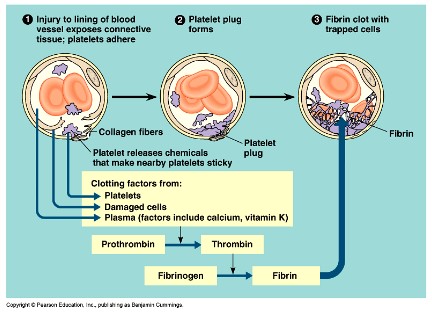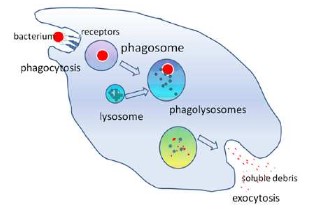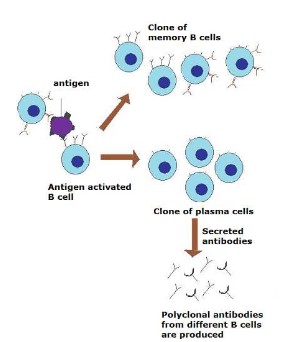Topic 6: Human physiology
6.3 Defense against infectious disease
First line defence – physical barrier
- Skin and mucous membranes are physical barriers against infection from pathogens, including bacteria, virus, fungi and parasite
- Skin is continuous, so it is very hard to find an opening for pathogen to invade.
- Skin is constantly replacing its outermost epidermal layer of skin. These dead cells provide effective protection against foreign pathogens.
- Skin has about a pH about 5, which is not favorable to pathogens.
- There are lysozyme on the skin, which can break down pathogens
- Natural organism presents on the skin will compete living environment with pathogens.
- Mucous is sticky and traps foreign particles and pathogens contained in the air before they reach the lungs.
- Mucous contains lysozymes (enzymes) that can damage and kill pathogens.
- Trapped pathogens can also be expelled through the mouth or nose, or swallowed and destroyed by the high acidity of the stomach.
- There is also unfavorable pH and natural organisms in mucous
Blood Clotting
- Blood clotting is the process in which cuts or broken blood vessels are repaired and sealed to prevent excessive blood loss.
- When a blood vessel is broken or cut, blood platelets collect at the site of the damaged blood vessel forming a platelet plug.
- The platelets and the damaged tissue release chemical factors called clotting factors.
- The clotting factors convert the clotting protein prothrombin to its active form thrombin (enzyme).
- The enzyme thrombin converts clotting protein fibrinogen (which is soluble) into the insoluble fibrous protein fibrin.
- Fibrin forms a mesh at the point of the broken vessel further trapping other blood cells sealing up the damaged vessel and forming a stable clot.
- Once the damaged vessel has fully healed, the blood clot dissolves in the blood

Atherosclerosis
- Atherosclerosis is a disease of the arteries characterized by the deposition of plaques of fatty material on their inner walls. (blood clots in artery)
- Damaged coronary arteries wall leads to a growth of fibrous tissue, which will trap cholesterol.
- Plague of cholesterol will form on the artery
- High pressure of blood opens up the artery.
- Red blood cells bind to the plague.
- It will reduce blood flow, causing death of heart cells.
- Myocardial infarction (heart attack) occurs if a coronary artery becomes completely blocked.
- Coronary muscle tissue dies as a result of lack of oxygen.
- Risk factors: genetics/age/smoking/diet/exercise/obesity/stress
- Bypass surgery can avoid the block and supply blood to the heart
Phagocytes
- Phagocytes use chemotaxis to find pathogens.
- Chemotaxis: movement in response to chemicals
- Protein produced by pathogen and phospholipids released by damaged cells will attract phagocytes to come
- Phagocytes attach to the pathogen’s cell surface protein and then engulf it.
- Once the pathogen is engulfed, lysosomes within the phagocyte contain hydrolytic enzymes that will digest and destroy the foreign pathogens.
- Using endocytosis to engulf pathogens to form phagosome.
- Lysosome attaches to phagosome to form phagolysosome, which destroy the pathogens inside
- The corpse is expelled by exocytosis

Lymphocytes
- When a pathogen enters the blood, the specific antigen on the surface of the membrane is identified as being foreign or non-self
- This stimulates a specific immune response in which antibodies are produced that are specific for that particular antigen
- Antibodies: globular protein that recognizes a specific antigen and binds to it as a part of an immune system
- Antigen: substances found on a cell or virus causes antibody formation.
- B-lymphocytes are white blood cells that produce antibodies that bind to the antigen on the invading pathogen
- Once an antigen has been encountered the B-lymphocytes are stimulated to divide to produce a large amounts of clones of themselves (clonal replication)
- The active B-lymphocytes that are produced are called plasma cells which will begin to produce antibodies.
- The plasma cells created, produce and release mass amounts of antibodies into the bloodstream.
- Plasma cells fire antibodies to antigens and signal phagocytes to destroy them
- Some of these divisions also produce B-cells called memory cells, which stay in the blood in case of a second infection to provide a quick response to the new infection.
- The primary response is the production of antibodies to the initial challenge by the invading antigen.
- The secondary response which is much quicker because memory cells are still in the blood occurs after a subsequent challenge by the same antigen.
- Memory cells create immunity

Antibiotics
- Antibiotics are a type of drug or chemical that inhibits the growth of microorganisms; mainly bacteria
- Antibiotics block cellular processes such as DNA replication, transcription, translation, and cell wall formation
- The first antibiotic discovered by Alexander Fleming was identified as penicillin
- Later on, two scientists named Florey and Chain were able to develop a method of growing the Penicillin in liquid cultures and purifying the Penicillin in these cultures.
- Since viruses lack their own metabolism, they have to use the chemical processes of a cell from a host that they infect
- They are unable to reproduce on their own and cannot perform protein synthesis, transcription and other metabolic functions
- Antibiotics work by blocking these vital processes in bacteria, killing the bacteria, or stopping them from multiplying
- Virus lacks metabolic pathways so antibiotics won’t work on them
- Antibiotic resistance may develop due to evolution by natural selection, mutation, fast division
Vaccination
- Active immunity can be acquired through vaccination.
- A vaccine is a weakened version of a pathogen.
- It is introduced to the body through an injection, which causes a primary immune response to the pathogen.
- This will create the plasma B-cells necessary to fight off the initial infection from the vaccine and the memory B-cells necessary for a secondary immune response if the person is exposed to the real pathogen.
- This secondary response is much quicker and more intense producing more antibodies in less time
- Sometimes “booster shots” are given which is a second round of vaccination that causes a secondary immune response.
HIV
- HIV (human immunodeficiency virus) is a retrovirus that causes AIDS, which is a condition in humans where the immune system fails and is susceptible to life-threatening opportunistic infections.
- HIV targets helper-T cells
- Helper-T cells play an important role in the production of clonal B lymphocyte cells, which produce antibodies for immune response.
- Therefore the reduction of T cells will reduce the amount of antibodies produced needed to fight off infection from invading pathogens.
- This inability to fight off disease is what eventually causes the person to die.
- HIV is a retrovirus, which means it inserts its own DNA into the host cells and use their cellular machine to reproduce
